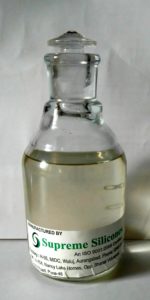Silicone Surfactants Surface active agents, or surfactants, are products that, at very low concentrations, markedly reduce the interfacial surface tension of liquid-gas, liquid-liquid and liquid-solid interfaces. Depending upon their behavior, at such interfaces surfactants can function as wetting agents, emulsifiers, detergents, dispersants, foaming agents, solubilizers, etc. and are therefore useful in many industrial applications.
Surfactants have two distinct components in their molecular structure: a hydrophobic (water-repelling) portion and a hydrophilic (water-attracting) portion. The combination of these distinct hydrophobic and hydrophilic parts within a single molecule accounts for the reduced surface tension and the other important properties that are characteristic of this group of chemical compounds.
Traditional surfactants have carbon chains as the hydrophobic portion of the molecule. The hydrophile that is added to the carbon chain will determine the solubility and the general class of surface active agents as anionic, cationic, nonionic or amphoteric.
A series of surfactants which are based upon silicone as a hydrophobe that contain other functional groups, similar to those seen in traditional surfactants have been and continue to be developed. In some instances, silicone is incorporated into a surface-active agent, with a polyoxyalkylene portion of the molecule and or a hydrocarbon portion of the molecule. As will become clear, this results in several unique properties of the surfactant. Historically, silicone compounds have been available as water insoluble oily materials.
Supreme Silicones is specializes in the creation of unique silicone-based surfactants, where the hydrophobic portion of the surfactant comprises a siloxane backbone. By adding various organic or inorganic functional groups, which by their nature may be nonionic, anionic, cationic or amphoteric (then referred to as organo-silicone compounds) to various siloxane chains or networks, Supreme Silicones can offer a truly endless variety of products with unique and desirable properties.
MOL. STRUCTURE OF SS SUF 100
Silicone Surfactants are used as a Super Wetting and Spreading Agent, which have a low molecular weight, nonionic, developed to improve the wetting, spreading and penetration of agricultural chemicals.
As Super wetting Agent reduces surface tension below 22 dynes/cm, which produces very rapid wetting and spreading on hard-to-wet surfaces such as waxy leaves. Thus, complete coverage can be achieved with herbicides, insecticides, fungicides and other agricultural chemicals. It may be used as a formulation ingredient in pesticide products, or as a tank-mix adjuvant for foliar applied chemicals
Silicone surfactant, in addition to the rapid wetting and spreading action, also greatly increases the uptake of chemicals into plant tissues.
Potential Applications
Silicone Surfactant adjuvant has been used successfully in spray applications globally.
INDUSTRIAL APPLICATIONS:
Agriculture : As wetting agent enhances performance of herbicides and pesticides
by dramatically reducing the product’s surface tension, results in better spread and
penetration of herbicides on the targeted leaves. This improved efficacy and to
minimize the amount of the chemicals needed.
Inks and Coatings: Provides better slip, improved mar resistance, better levelling
and foam control. Effective at very low concentrations hence are cost effective.
Textiles: Provide defoaming, lubrication, final product’s softness, feel, wear ability,
versatility and improved processing during the manufacturing stage.
Pulp and Paper: Improve various defoaming, drainage and better release. Also
increases softness, absorbance or repellence of final products.
Personal Care : Improved softness, shine, conditioning, detangling and
emollience. Also used as emulsifiers for creams and sun care products to
improve stability and efficacy aesthetic delivery.
Leather : Improve both natural and synthetic leather’s feel, softness, durability,
abrasion resistance and resistance to soiling.
Automobile : Improve gloss, shine and beading to various products.
Oil and Gas : As organic demulsifier. As processing aids in many applications.
Polyurethane Foam : As stabilizers for the polyurethane foam industry
Typical applications include:
Application Typical Use Rate(a)
Plant Growth Regulators 0.025% to 0.05%
Herbicide 0.025% to 0.15%
Insecticide 0.025% to 0.1%
Fungicide 0.015% to 0.05%
Fertilizers and Micronutrients 0.015% to 0.1%
